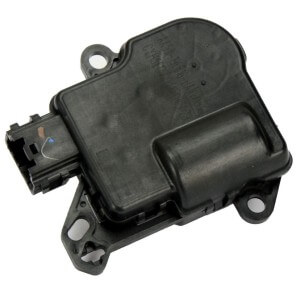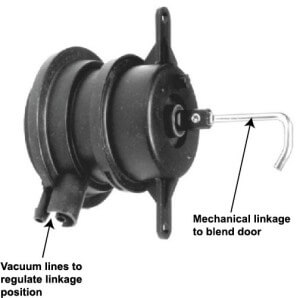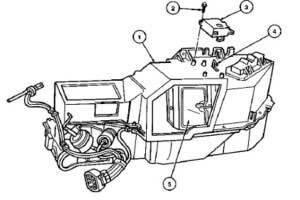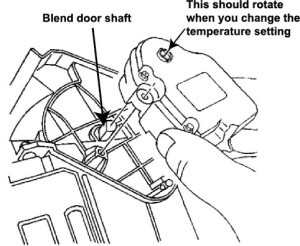No heat in car — Most common causes and fixes
No heat in car or blowing cold air
These are the most common cause of no heat in car or heater is blowing cold or cool air
1) A low coolant level is the most common cause of no heat in car
Check the coolant level in the coolant reservoir in the engine compartment. If it’s below the minimum line or is empty, top off with the recommended coolant.
Heater core tip: Hot coolant (around 200°F) enters the heater core from the engine. Cabin air blows across the heater core and removes some heat from the coolant. However, the exiting coolant is still hot. To check the operation of your heater core, touch both heater hoses at the firewall. Both hoses should be hot. If only one hose is hot, your heater core is most likely plugged with rust or leak sealer.
2) Faulty blend door or blend door actuator can cause no heat in car or cool air
The heater core might be getting hot coolant from the engine, but if the blend door isn’t working properly, you can still get no heat. The blend door is what regulates cabin temperature by opening or closing off airflow from the heater core. When you turn the temperature control on your car’s HVAC panel, it commands an small electric or vacuum motor to open or close a “blend door.” The blend door varies how much air passes across the heater core and that determines how much heat comes out the vents.
A stuck open blend door or faulty blend door actuator can cause the air to be
cold or cool.
Use a shop manual to locate the blend door actuator. Watch the actuator as you move the temperature controls to see if it’s moving the blend door. If the actuator doesn’t move, remove it from the heater box and try moving the blend door by hand. If th

An electronic blend door actuator opens and closes a blend door to regulate the air temperature in your car
e blend door moves by hand, then the problem is the actuator. Replace it.
Test the vacuum motor
If the vacuum motor is receiving vacuum but not operating the blend door, the problem may be a cracked diaphragm or a binding blend door. Remove the vacuum motor and move the blend door linkage by hand. If the blend door moves freely, replace the vacuum motor
Test an electronic blend door actuator
Locate the blend door actuator and observe the motor while adjusting the heat setting (key in RUN position).
The motor should rotate and open and close the blend door. If the motor doesn’t move, unscrew it from the heater box and try moving the blend door by hand. If the door moves easily, then the problem is in the blend door actuator or the heater control head. Consult a shop manual for the electrical tests to determine whether the motor or the control is at fault.
If the door binds and cannot close properly, or the actuator fails, the door may remain open. Depending on the design of the heater box, that could cause a heat always on condition. If the motor fails when the door is closed, that could cause a no heat in car condition.
During air conditioning season, a bum blend door actuator can fail in a full or partially open position. In that case it heats the newly cooled air from the air conditioning evaporator coil, cancelling out the cooling effect of the air conditioning.
3) Check the heater control valve
Some vehicles don’t use a blend door and actuator to control cabin air temperature. Instead, they vary how much hot coolant enters the heater core by using a heater control valve. Heater control valves can be operated by a cable, vacuum motor, or electric motor.
To check the operation of a heater control valve. touch the incoming and exit heater hoses. If the valve is open, both hoses should be hot. If only one hose is hot/warm, the valve is closed. If you have a cable operated valve, try moving the lever by hand to open the valve. If you have a vacuum or electric valve, follow the diagnostic procedure shown in your shop manual.
4) A stuck open thermostat can cause a no heat condition
Here are the symptoms of a stuck open thermostat:
• The air gets warmer when you’re stopped at a stop sign. This happens because there’s no ram air going through the radiator, so the coolant stays a bit warmer. If you have warmer air when stopped and it gets colder when you drive, suspect a stuck open thermostat.
• The engine takes longer than normal to warm up. Since coolant is circulating through the radiator at all times, the engine won’t be able to heat up to its proper operating temperature as quickly. This can mean poor fuel economy and emissions performance when cold.
• The temperature gauge reads lower than normal. The driver will notice the temperature needle staying under the halfway point, sometimes near the “C” cold mark, even after the engine has been running for several minutes.
© 2014 Rick Muscoplat



